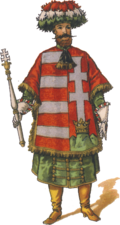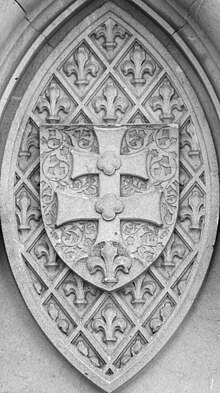
Back شعار المجر Arabic شعار المجر ARZ Macarıstan gerbi Azerbaijani Венгрия гербы Bashkir Герб Венгрыі Byelorussian Герб Вугоршчыны BE-X-OLD Герб на Унгария Bulgarian হাঙ্গেরীর চিনত্হান BPY Grb Mađarske BS Escut d'Hongria Catalan
| Coat of arms of Hungary | |
|---|---|
 | |
| Versions | |
  The coat of arms may also be used in other historical forms.[1] | |
 | |
| Armiger | Hungary |
| Adopted | 3 July 1990[2] |
| Crest | Holy Crown of Hungary |
| Shield | Barry of eight Gules and Argent, impaling Gules, on a trimount Vert a ducal coronet Or issuing therefrom a Patriarchal cross Argent |








The coat of arms of Hungary (Hungarian: Magyarország címere) was adopted on 3 July 1990, after the end of communist rule. The arms have been used before, both with and without the Holy Crown of Hungary, sometimes as part of a larger, more complex coat of arms, and its elements date back to the Middle Ages.
The shield is split into two parts:
- The dexter (the right side from the bearer's perspective, the left side from the viewer's) features the so-called Árpád stripes, four Gules (red) and four Argent (silver) stripes. Traditionally, the silver stripes represent four rivers: Duna (Danube), Tisza, Dráva, and Száva.[4]
- The sinister (the left side from the bearer's perspective, the right side from the viewer's) consists of an Argent (silver) double cross on Gules (red) base, situated inside a small Or (golden) crown, the crown is placed on the middle heap of three Vert (green) hills, representing the mountain ranges (trimount) Tátra, Mátra, and Fátra.
Atop the shield rests the Holy Crown of St. Stephen (Stephen I of Hungary, István király), a crown that remains in the Parliament building (Országház) in Budapest today.[5]
- ^ "National Symbols: The Coat of Arms". www.keh.hu. Office of the President of the Republic. Archived from the original on 25 September 2021. Retrieved 12 February 2017.
- ^ "1990. évi XLIV. törvény a Magyar Köztársaság Alkotmányának módosításáról" [Act XLIV of 1990 on the Amendment of the Constitution of the Hungarian Republic]. hu.wikisource.org (in Hungarian). Retrieved 12 February 2017.
- ^ Bertényi, Iván (1998). Új magyar címertan [New Hungarian heraldry] (in Hungarian). Budapest: Maecenas Könyvkiadó. ISBN 963-7425-81-0.
- ^ Betsy Dru Tecco: How to Draw Hungary's Sights and Symbols, The Rosen Publishing Group, New York, 2005 [1]
- ^ Betsy Dru Tecco: How to Draw Hungary's Sights and Symbols, The Rosen Publishing Group, New York, 2005 [2]
© MMXXIII Rich X Search. We shall prevail. All rights reserved. Rich X Search